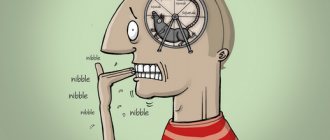What kind of diagnosis is this
Understanding what kind of diagnosis this is is necessary in order to find the right approaches to treatment, rehabilitation and resolve expert issues related to work ability. Common people may be confused between the definition of “organic personality disorder” and “organic asthenic disorder” or any other disease caused by a problem in the brain under the heading F06. The key difference is the change in personality and behavior characteristic of the first and the lack of transformation of a person’s individuality for the second.
Which doctors should you contact if you have Dissociative (Conversion) Disorders?
The doctor to consult for symptoms indicating the presence of dissociative (conversion) disorders is a psychiatrist. If you suspect dissociative (conversion) disorders in yourself or your loved ones, the best specialists in the field of psychiatric medicine conduct consultations at the Mosmed clinic. They will provide you with detailed information about treatment methods and methods, signs and symptoms of disorders, preventive measures and rehabilitation.
Primary appointment with a neurologist: 1850 RUR.
Sign up Online 5% discount when registering from the site
Etiology
The causes of mental disorder, that is, the etiology, are as follows:
- epilepsy and other pathologies affecting the brain (trauma, tumors);
- toxins;
- hormonal diseases;
- severe somatic diseases;
- vascular disorders.
Often, especially with age, factors can overlap one another.
May be due to disease, injury or dysfunction of the brain
Brain disorders (epilepsy and others)
The appearance of personality changes in connection with epilepsy is individual and primarily depends on the frequency of attacks. The more often seizures occur, the more damage occurs to the cerebral cortex. Accordingly, the more pronounced transformations will occur to a person. Tumor or traumatic brain injury, especially in the frontal lobe, also leads to organic disorder.
Exposure to toxins
Toxic effects on the brain include not only working with harmful substances, but also consuming alcohol or its surrogates, leading to liver cirrhosis and hepatic encephalopathy.
Drug abuse will leave an indelible mark on a person's personality.
Hormone exposure and endocrine disruption
Dishormonal pathologies leading to organic personality changes:
- diabetes mellitus (decompensation leading to encephalopathy);
- thyrotoxicosis;
- pathologies of the adrenal glands;
- diseases of the hypothalamic-pituitary system.
As a result of deteriorating hormonal levels, brain structures, including gray matter, suffer, which further leads to personality changes.
Somatic diseases
Common diseases that decompensate for worsening brain function at the level of cellular damage include:
- liver cirrhosis (hepatic encephalopathy);
- malignant tumors at the last stage;
- chronic renal failure in the terminal stage.
The development of brain pathology is similar to that which occurs under the influence of toxic substances coming from the outside.
Psychosomatic seven, capable of provoking an organic disorder
Vascular origin
Organic personality disorder of vascular origin occurs when the cortex is damaged due to insufficient nutrition.
The reasons may be:
- cerebral infarctions (ischemic, hemorrhagic);
- discirculatory encephalopathy of the third degree.
Mixed genesis
Organic personality disorder of mixed origin occurs when any of the above-described diseases or brain injuries are combined. An example would be dyscirculatory encephalopathy in an epileptic or traumatic brain injury in a drug addict.
Symptoms and diagnosis
Conversion disorders according to clinical characteristics are divided into three groups: motor, sensory (sensitive) and dissociative with mental symptoms.
Motor symptoms of conversion disorder
They come in two types: hyperkinesis and hypokinesis. Hyperkinesis is unintentional movements of skeletal muscles:
- trembling, flapping;
- convulsions;
- rhythmic jerking of the head or arms;
- blepharospasm.
Motor symptoms become more pronounced when a person catches the gaze of others, that is, there is an element of demonstrativeness.
This also includes a hysterical seizure, simulating a generalized convulsive seizure. It is accompanied by impaired consciousness, falling onto a soft surface, and autonomic disorders.
Hypokinesis or akinesia are manifested by impaired muscle strength: hysterical paralysis, paresis.
Sensory symptoms
Manifested by sensitivity disorders. The most common symptoms: complete or partial loss of sensitivity, severe body pain, hysterical blindness or deafness; the “stocking or glove” symptom, which is manifested by loss of sensation in the hand or foot.
Dissociative symptoms with mental disorders
These include: psychogenic amnesia, dissociative fugue, dissociative stupor, Ganser syndrome.
The main thing in diagnosis is to distinguish the origin of the symptoms, since they can be organic in nature. For this purpose, differential diagnosis is carried out using instrumental methods: magnetic resonance and computed tomography, neurological tests.
An external assessment of symptoms is carried out. For example, the main differences between a hysterical seizure and a true epileptic seizure are that it lasts longer than 3 minutes, the patient falls on a soft surface (so as not to hit himself); there is no amnesia after the attack; consciousness is not completely impaired; there is no specific cry during a fall; the convulsions disappear when the bystanders leave.
Behavioral symptoms, ICD codes
ICD-10 code for organic personality disorder F07.0. It is used for coding medical records.
Changes in the pattern of emotions and behavior, symptoms of thought disorder, and sexual dysfunction are key to identifying a personality disorder.
These symptoms last for at least six months and include at least three manifestations from the list:
1. A person is unable to carry out his usual daily work, achieve his goal, especially if he needs to do something for a long time.
2. Emotional transformations:
- lability, that is, instability of emotions, mood swings, loss of control;
- euphoric state, flat humor, inappropriate jokes;
- increased irritability, angry outbursts, aggressive behavior;
- lack of desire to do anything (apathy).
Emotional instability
3. Neglect of social rules in pursuit of fulfilling one's needs, leading to antisocial behavior (theft, demonstration of sexual desires in public, gluttony, lack of personal hygiene).
4. Mental pathological symptoms:
- super-dimensional suspicion;
- fixation on one topic (religion, politics, medicine);
- categoricalness in judgment, criticizing any other point of view as absolutely wrong.
5. Changes in speech (its tempo, the appearance of intrusiveness, thoroughness, viscosity, increased detail).
6. Changes in the sexual sphere (change of sexual preference, disinhibition, lack of a sense of distance).
Emotionally labile disorder (asthenic)
Emotionally labile disorder in ICD-10 belongs to category F06 (F06.6) and is characterized by the absence of personal transformations. The main symptoms are:
- emotional instability (mood swings, tearfulness, weakness);
- weakness, fatigue, apathy;
- dizziness, headache, ringing or noise in the head.
All this occurs against the background of a disease directly or indirectly affecting the brain (dyscirculatory encephalopathy, hypertension, hormonal disorders, tumors, head injury).
Symptoms subside when the causative disease is compensated
With mild cognitive impairment
Organic disorder with mild cognitive impairment (F06.7) is manifested by:
- memory loss;
- reduced ability to learn new skills;
- problems with logical sequential thinking;
- difficulty speaking when choosing words or counting;
- poor concentration;
- severe fatigue when performing mental work.
Pathological symptoms must last for at least two weeks against the background of a disease leading to brain dysfunction.
Anxiety disorder
Organic anxiety disorder (F06.4) occurs as a result of brain damage and is characterized by increased anxiety as a leading symptom.
Dissociative disorder
Features of organic dissociative disorder (F06.5) are:
- loss of memory for recent events;
- disturbance of movements in the limbs;
- loss of sensitivity or, conversely, severe discomfort in the body.
Dissociative identity disorder
Affective disorder
Organic mood disorders are associated (F06.3) with brain pathology without transformation of a person’s personality and are characterized by depressive symptoms, as well as, conversely, increased background or phase changes from a decrease in the emotional curve to euphoria.
Delusional schizophrenia-like disorder
Organic delusional disorder (F06.2) is characterized primarily by the presence of delusions, which may be constantly present or occur with varying frequency. Hallucinations are possible. To recognize and distinguish it from schizophrenia, it is necessary to examine a person to identify organic brain damage.
Catotonic state
Organic catatonic disorder (F06.1) is detected when:
- stupor, that is, freezing in one position without movement, speech, reactions to external influences;
- negativism, that is, resistance to changing body position;
- instead of stupor, agitation with chaotic movements is possible;
- the change of the above states is rapid.
Organic hallucinosis
The basis of the pathology coded F06.0 is the presence of hallucinations (visual, auditory) with unchanged consciousness. The person’s criticism is preserved, that is, he understands that the visions are not real.
Visions frighten a person
Causes of dissociative disorder
Dissociation is a specific mechanism by which the mind splits into component parts or separates certain memories, images, thoughts of consciousness. Such split subconscious mental images are not erased and can spontaneously reappear in consciousness due to the influence of certain triggers, which are called triggers. Objects, events, and circumstances surrounding the individual during the occurrence of a traumatic event can serve as such triggers.
This condition is caused by a combination of several reasons, such as the ability to dissociate, severe stress, the demonstration of protective mechanisms in the processes of ontogenetic development and childhood due to a lack of care and compassion for the baby during a traumatic experience or a lack of protection from subsequent hostile experiences. After all, children are not born with a sense of a single identity. Identity is formed based on a large number of sources and many experiences. Under critical conditions, children's development is hindered, and some parts of what should have been integrated into a relatively unified identity remain segregated.
Numerous studies show that almost 98% of adults with a history of dissociative identity disorder report incidents of violence in childhood. Such violence can be documented in 85% of the adult population and 95% of children and adolescents with multiple personality disorder and other similar forms of dissociative disorder. Such research data demonstrate that in childhood violence is one of the main causes of dissociative disorder. However, some patients had no history of violence, but all had experienced early loss of a loved one, serious illness, or other major stressful events.
The process of human development requires the individual to be able to successfully integrate different forms of complex information. During ontogenetic formation, an individual goes through a number of stages of development, in each of these stages different personalities can be created. The ability to produce multiple personalities is not found or found in every child who has suffered violence, severe loss or trauma in childhood. Patients with dissociative disorder have the ability to freely enter trance states. This skill, combined with the ability to dissociate, acts as a factor in the development of the disorder. At the same time, most children who have these abilities also have adaptive mechanisms that correspond to the norm, but are not in circumstances that provoke dissociation.
Dissociation is a serious and rather lengthy process with a huge spectrum of action. Just because an individual has dissociative disorder does not mean that they have a symptom of mental illness. A less pronounced degree of dissociative disorder can occur as a result of stress factors, in subjects who spend a long time without sleep, or when suffering a minor accident. Another simple example of a dissociative disorder in individuals is the periodic complete fascination with a film or book, which leads to the fact that the world around us simply ceases to exist, and time passes unnoticed.
So, dissociative identity disorder is often closely associated with exposure to stress factors that lead to stressful conditions in individuals. And stressful conditions can occur after suffering various traumas, as a result of abuse, internal personal conflicts, attention deficit and immense empathy in childhood, the ability to share one’s own memory and identity from awareness.
Since individuals are not born with a sense of personal unity, children who experience stress remain divided. Patients with identity disorder often experienced severe or persistent violence in childhood, which can be either physical or sexual. Therefore, children living in unfavorable living conditions experience a disconnection of various feelings and emotions. Such children develop the ability to protect themselves from difficult life conditions by withdrawing into their own special world. Each stage of formation can form new personalities.
Treatment
Treatment of an organic disorder consists of the following elements:
1. Symptomatic therapy:
- mood stabilizers for emotional lability (carbamazepine, topiromate);
- anxiolytics for anxiety and irritability (benzodiazepines for no more than 1 month);
- antipsychotics for behavior correction and sedation;
- antidepressants for apathy and reduced emotional background (maprotiline, fluoxetine, sertraline, paroxetine, escitalopram).
2. Etiotropic therapy for an established cause of the disorder (vascular, nootropic, antiepileptic, hormonal and other drugs).
3. Psychotherapy and psychocorrection.
Tests for diagnosing disorders
The test for the presence of a mental disorder reflects different areas of a person’s life.
Psychodiagnostics can be divided into:
- personality research (Minnesota Multidimensional Personality Inventory MMPI or adapted SMIL, Strelyau questionnaire, Eysenck test, Cattell test questionnaire 16PF and others);
- analysis of thinking (Lachins method, exclusion of concepts, analysis of proverbs, etc.);
- memory test (method “10 words”, associations, A. N. Leontiev’s method, Wechsler test and others);
- intelligence tests (Wechsler test, Raven matrices, Guilford matrices and others);
- attention research (Schulte tables, Münsberger test, Kraepelin count and others);
- study of the emotional-volitional background (HADS, Beck, Zang, Hamilton scales).
Non-organic personality disorders
This group of diseases reflects the pathological character of a person, his emotions and relationships with other people. The disorders are not associated with brain damage.
Personality disorders
Schizoid
A sick person tries to move away from any contact with other people as much as possible and does not accept the rules generally accepted by society. All his emotions are flattened to complete indifference. He is absorbed in his fantasies and is cold.
Schizotypal
Schizotypal disorder (F21) is a separate disorder. It is characterized by:
- alienation, coldness of emotions;
- eccentric behavior or appearance;
- great difficulties in communicating in society;
- oddities in views and beliefs;
- excessive suspicion to the point of paranoia;
- obsessions;
- illusions, a feeling of unreality of the environment and what is happening;
- thoroughness of thinking along with oddities in speech;
- rare attacks of hallucinations and delusional ideas.
To be diagnosed, the condition must have been present for at least two years with at least four of the above symptoms present.
Narcissistic
It is not a disease and requires the exclusion of other personality disorders.
Signs:
- excessive emotionality when communicating with other people;
- abnormal behavior style to attract everyone's attention;
- constant concern about the opinions of others;
- actions aimed at obtaining evidence of one’s rightness and influence, along with hypersensitivity to criticism;
- narcissism;
- egocentrism.
Narcissism is a character trait and can come in varying degrees of severity.
Dissociative
Otherwise known as multiple personality disorder (F44). It is characterized by the presence of several personalities in the patient, replacing each other in his consciousness and never intersecting. Each of them has its own behavioral characteristics and memory.
Bipolar
Bipolar disorder (F31) is manifested by depressive states, alternating with increased energy and the development of activities of varying intensity. The duration of the phases of depression and mania (hypomania) can vary - from several hours to months and even years.
Border
This type of personality disorder is characterized by the following features:
- lack of vision of one’s “I”, goals, preferences and decisions;
- constant involvement in unhealthy relationships that lead to deterioration of the condition;
- fear of being abandoned and making every effort to prevent this from happening;
- self-harm or manipulation through talk of suicide;
- feeling of inner devastation.
Borderline personality states











